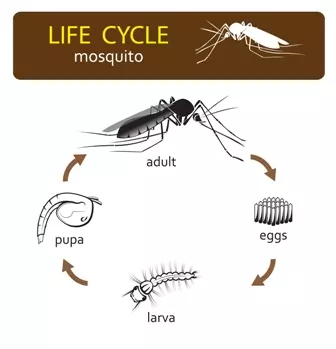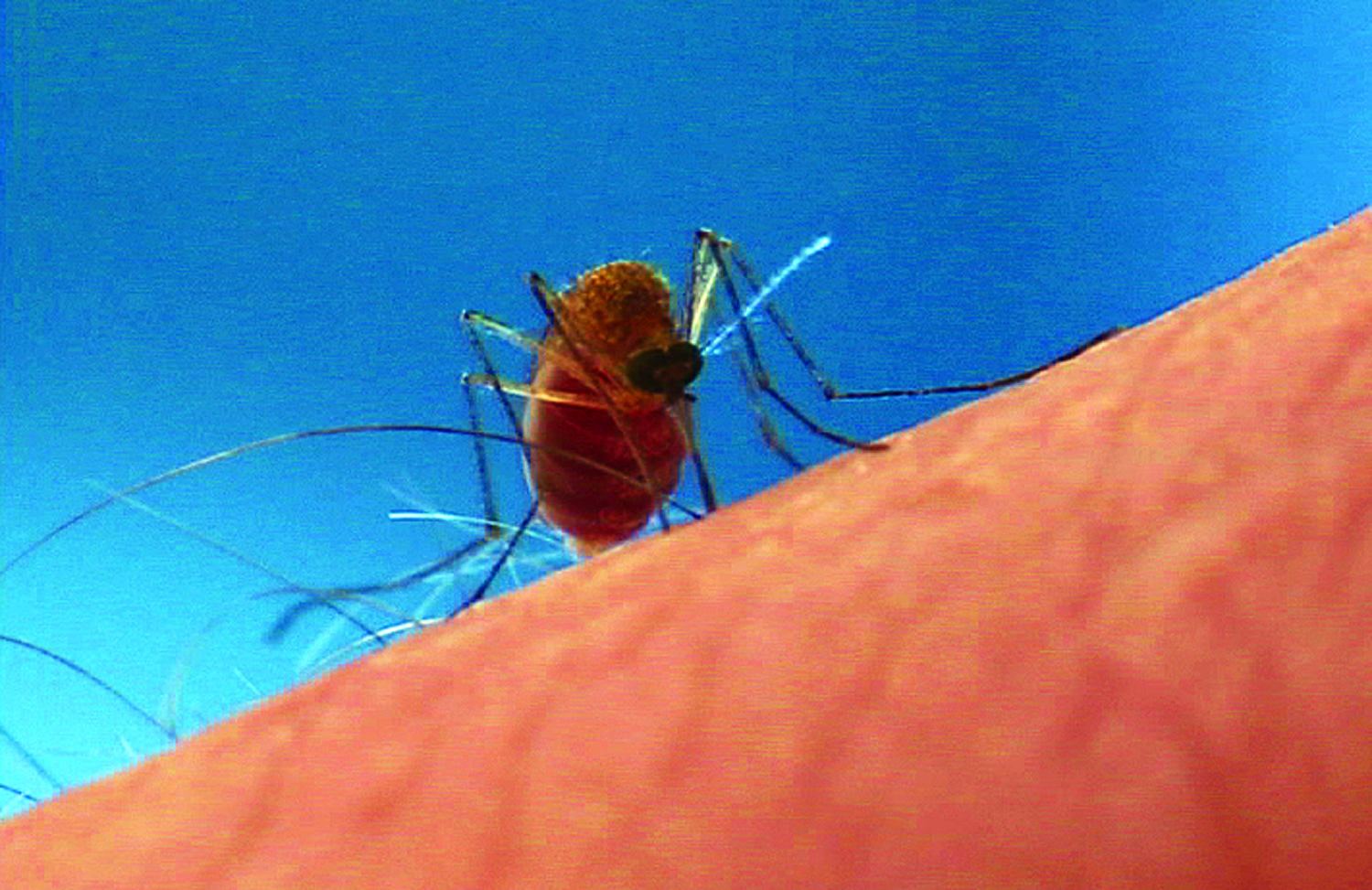Mosquito Life Cycle
Birth Of A Bloodsucker: A Mosquito’s Life
If there’s anything good about mosquitoes, it’s that they don’t live very long. The entire mosquito life cycle can be counted in days.
Once they emerge from their pupal cocoons and take flight, male mosquitoes last less than a week, the females maybe a couple of months, and that’s only with ideal conditions.

The bad news is that they are an extremely hardy type of insect. According to the University of California-Davis Mosquito Research Program, mosquitoes have been around for at least 210 million years.
They don’t travel much, typically not more than a mile from the place where they were hatched, and their sole purpose seems to be laying more eggs to make more mosquitoes. A female can produce up to 500 eggs before she finally dies.
And here’s a creepy little bit of information: Your blood helps mosquitoes perpetuate the species, and not in the way you probably think. But more about that later on. Right now, let’s start with eggs, the first of four stages in the mosquito life cycle.
That’s Not A Speck Of Dirt, It’s A Raft Of Mosquito Eggs
You’ve probably seen the TV news segments telling you to never, ever leave standing water around your yard because it can become a breeding ground for mosquitoes.
The reason for the warning is that mosquito eggs require water in order to develop. Almost any kind will do, from stagnant rain water to the condensation found inside an old tire, as long as the water is not likely to be disturbed for a week or two.
There are about 3,500 species of mosquitoes throughout the world, and roughly 176 of them can be found in the United States. The most common is the Culex pipiens.
The female mosquitoes of Culex and most other species lay their eggs in batches of 50 to 100, often in tiny clumps about a quarter-inch long that float together on the surface of the water like a raft. They make those deposits on water that’s collected in tree holes, ditches, even your dog’s water dish.
However, some species will lay mosquito eggs on moist, often-flooded soil in anticipation of the next rise in water. Those eggs can survive winter, waiting for spring or summer rains to cover them over.
Read Also: 25 Best Things you can do with an MBA Degree
Females usually deposit their eggs at night, and can lay them about every third night, up to three times.
Entomologists at Oklahoma State University report that the eggs are white when first deposited, then darken to near black within a day. They will hatch in one to three days, depending on the temperature. Eggs left on moist soil can last for up to a year, until the ground is flooded again, before hatching.
When the eggs hatch, the mosquito larvae come out.
Mosquito Larvae Wiggling All Around
This is the baby stage for mosquitoes.
The larvae are aquatic creatures that feed on algae, bacteria and other microorganisms in the water. Certain mosquito species will even eat each other. They spend most of their time hanging upside down at the surface, sucking in oxygen from breathing tubes located in their tails.
They’re often called “wigglers” because that’s how they move in the water, propelling themselves with a frantic twitching motion. At this stage, a mosquito larva is vulnerable to predators such as fish and birds, as well as other mosquito larvae.
The New South Wales Department of Natural Resources in Australia describes them as “hairy maggots with siphons,” covered on the lower half by a cocoon.
Because mosquitoes are cold-blooded and rely on external heat sources to warm their bodies, development depends on the temperature. The warmer it is, the faster the mosquito larvae will grow.
Most larvae develop over about a week or so, shedding their skins – known as molting – four times on the way to becoming mosquito pupae. The molting stages are call instars. By the fourth one, each one mosquito larva is almost a quarter-inch long.
Mosquito Pupae Rest Up For The Big Debut
The mosquito pupae – called “tumblers” – do not feed. In fact, they don’t do much of anything except swim around in the water. Think of this as the teenage stage of the mosquito life cycle.
They have short, curved bodies with a large head at one end and flippers for swimming at the other. They are lighter than water, so they live at the surface and, like the larvae, they must take in oxygen from time to time through two breathing tubes known as “trumpets.”
When disturbed, mosquito pupae tumble down to the safety of deeper water and eventually float back to the surface. Again, like the larvae, they are vulnerable to birds and fish. They’re also vulnerable to people. Just put a little bit of an oily substance in the water, and a mosquito pupa will be unable to break through to get oxygen.
Otherwise, inside their cocoons, they are developing into those flying insects we all hate. It can take up to four days, depending on the temperature of the water. Once the pupal tissue has developed into adult mosquito form, the adult uses air pressure to split the cocoon and emerge.
The new mosquitoes will rest on the surface – which is one reason eggs are deposited in still water – until their wings dry out and their bodies harden.
Then, they take off.
All Grown Up And Looking For A Mosquito Mate
Adult mosquitoes are made up of a head with two large compound eyes, a thorax, a pair of scaled wings and six jointed legs. They also have antennae and a proboscis.
Mosquitoes, both male and female, come out of the cocoon with two things in mind. They want to breed, and they want to feed, in just about that order.
Adult mosquitoes mate within the first few days after emerging. The male mosquitoes sometimes have to wait for about a day for their reproductive parts to fully develop. They locate females by listening for the sounds of their wings, which run about 250-500 beats per minute. The mosquitoes join, and the males pass sperm to the females, perpetuating the mosquito life cycle.
Once their job is done, male mosquitoes live three to five days. The females tend to mate only once, but live considerably longer, depending on how much warmth and moisture is in their environment. Under ideal conditions, they may last as long as a month or two.
Of course, they have plenty of predators to contend with. Bats and birds feed on mosquitoes, communities spray pesticides to kill them and homeowners use mosquito traps to attract and dispose of them.
The mosquitoes often stay within a short distance of where they emerged from their cocoons, although some species are capable of flying five miles or more. Slow fliers – about 1 mph – and easily dispersed by wind, they prefer to stay close to the ground.
Female Mosquitoes On The Hunt For Blood
Mosquitoes generally feed on plant nectar and fruit juice. Male mosquitoes do not take blood, so when you feel a mosquito plunge into your skin and start siphoning your blood, you can bet it is a female, every time.
Typically, female mosquitoes start hunting as the sun goes down and will continue a few hours into the night, searching for any warm-blooded creature, such as people, dogs, cats, birds, and wildlife.
Carbon dioxide which we exhale and lactic acid from our sweat combine to make us smell like a mosquito buffet. The insects can pick up the scent from 100 feet, and they can also see us moving and feel our body heat.
They use a serrated proboscis to pierce the skin and inject an anti-coagulant to keep the blood flowing and a mild painkiller, apparently to help them escape detection by their prey. The female mosquito will insert the proboscis into a capillary and withdraw as much blood as she can, up to three times her body weight.
If you are bitten by a mosquito, another thing you can assume is that you have just become a proud new parent, in a way. While female mosquitoes need nectar for nourishment, they also need protein to develop their eggs.
That protein comes from your blood. Once they’ve gotten blood, the mosquitoes fly away to a warm, damp place to rest and wait for their eggs to develop. That takes up to five days. The females lay their eggs, and then move on to the next blood meal to feed the next batch of eggs.
Read Also: How Much is Master of Business Administration Salary
Female mosquitoes can lay a set of up to 100 eggs about every third night after mating only once. They typically lay as many as three sets before dying.
Those eggs eventually hatch, and the whole mosquito life cycle starts over again.
Mosquito Life Cycle
Life Cycle Stages
The length of the mosquito life cycle varies between species and is dependent upon environmental conditions such as temperature and moisture. However, the life cycle of all mosquitoes is comprised of the egg, larval, pupal, and adult stages.

Eggs
Male mosquitoes feed on plant nectar alone, while females extract the blood of hosts in order to develop and nourish eggs. Most mosquitoes lay their eggs directly into water. Others lay their eggs near bodies of water but not within them.
Larvae
Eggs will hatch into larvae within 24 to 48 hours. Larvae soon grow to become approximately 5 mm in length. Most larvae breathe through air tubes. Larger larvae can be seen floating just above the surface of infested waters. Larvae and pupae usually cannot survive without water. If a water source evaporates before the larvae and pupae within it transform into adult mosquitoes, those young often will die.
Pupae
Within seven to ten days, larvae enter the pupal stage. Pupae are also visible upon the surface of the breeding site. After a mosquito is fully developed, it will emerge as an adult from its pupal case. At this time, the new adult stands upon the water and dries its wings to prepare for flight. Adult female mosquitoes will then seek an animal on which to feed. Females are capable of flying for miles if necessary and can lay over 100 eggs at a time.
Encounters & Concerns
Encounters
Where will a homeowner encounter the eggs, larvae, and pupae life cycle stages? Encounters with potential mosquito developmental sources can be places where you might not expect. Almost any source of water found on a homeowner’s property can support these developmental stages, and unless a homeowner is diligent to inspect their property, adults are going to be a problem.
Adult mosquitoes creating problems on your property may have come from a water source miles away, but also may have come from a water source located near your home. For example, two areas of concern that might not occur to homeowners are stopped up gutters that hold water and corrugated plastic downspout extensions that direct water away from the house.
Concerns
Mosquitoes are notorious for their involvement in disease transmission, creating annoyances, interfering with outdoor recreation activities, and even ruining a good night sleep. Another concern related to bites is the possibility of secondary infections of mosquito bites that are scratched and become infected with bacteria.
References
https://www.orkin.com/other/mosquitoes/mosquito-life-cycle
https://www.megacatch.com/mosquito-faqs/mosquito-life-cycle.html
